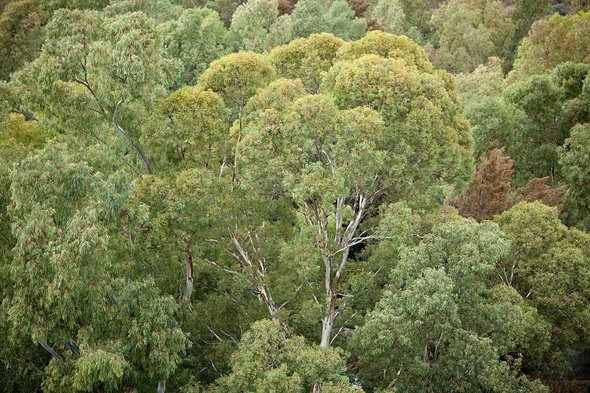(单词翻译:单击)
听力文本
Hi, I'm Scientific American podcast editor Steve Mirsky. Here's a short piece from the May 2018 issue of the magazine, in the section we call Advances: Dispatches from the Frontiers of Science, Technology and Medicine:
Sweaty Trees, by Yasemin Saplakoglu
Recent summer temperatures in parts of Australia were high enough to melt asphalt. As global warming cranks up the heat and climatic events intensify, many plants may be unable to cope. But at least one species of eucalyptus tree can withstand extreme heat by continuing to "sweat" when other essential processes taper off.
As plants convert sunlight into food, or photosynthesize, they absorb carbon dioxide through pores on their leaves. These pores also release water via transpiration, which circulates nutrients through the plant and helps cool it by evaporation. But exceptionally high temperatures are known to greatly reduce photosynthesis—and most existing plant models suggest this should also decrease transpiration, leaving trees in danger of fatally overheating. Because it is difficult for scientists to control and vary trees' conditions in their natural environment, little is known about how individual species handle this situation.

Ecologist John Drake of the S.U.N.Y. College of Environmental Science and Forestry and his colleagues grew a dozen Parramatta red gum — that's Eucalyptus parramattensis — in large, climate-controlled plastic pods that isolated the trees from the surrounding forest for a year in Richmond, Australia. Six of the trees were grown at ambient air temperatures and six at temperatures three degrees Celsius higher. The researchers withheld water from the surface soil of all 12 trees for a month to simulate a mild dry spell, then induced a four-day "extreme" heat wave: They raised the maximum temperatures in half of the pods (three with ambient temperatures and three of the warmer ones)—to 44 degrees C.
Photosynthesis ground to a near halt in the trees facing the artificial heat wave. But to the researchers' surprise, these trees continued to transpire at close-to-normal levels, effectively cooling themselves and their surroundings. The trees grown in warmer conditions coped just as well as the others, and photosynthesis rates bounced back to normal after the heat wave passed, Drake and his colleagues reported online in February in Global Change Biology.
Drake and his colleagues reported online in February in Global Change Biology.
The researchers think the Parramatta red gums were able to effectively sweat—even without photosynthesis—because they are particularly good at tapping into water deep in the soil. But if a heat wave and a severe drought were to hit at the same time and the groundwater was depleted, the trees may not be so lucky. Drake hopes to conduct similar experiments with trees common in North America.
That was Sweaty Trees by Yasemin Saplakoglu.
参考译文
大家好,我是《科学美国人》播客编辑史蒂夫·米尔斯基。下面是收录在本杂志五月刊“进展:科学、技术和医学前沿快报”版块中的一篇短文。
《出汗的树》 作者:雅丝敏·塞普拉科鲁
最近,澳大利亚部分地区的夏季温度高到足以融化柏油马路。由于全球变暖的加速和气候事件的加剧,许多植物可能无法应对。但当其他基本过程逐渐减少时,至少一种桉树能以不断“出汗”的方式来忍受极端高温。
植物将阳光转化为养分或进行光合作用时,它们会通过叶子上的气孔吸收二氧化碳。这些气孔还通过蒸腾作用释放水分,蒸腾作用使养分在植物体内循环,并通过蒸发帮助植物降温。但是,目前除了知道高温会令光合作用大幅减少之外,大多数现有植物模型认为,高温也应该能降低蒸腾作用,使树木处于致命过热的危险之中。由于科学家很难控制和改变树木在自然环境中的状况,因此现在人们对个体物种如何应对高温知之甚少。
纽约州立大学环境科学与林业学的生态学家约翰·德雷克和同事,在澳大利亚里士满可控制温度的大型塑料舱中种植了12棵帕拉玛赤桉树,即帕拉玛桉树,并将这些桉树与周围的森林环境隔离一年。其中6棵树种植在周围温度与环境温度一致的地区,另外6棵树种植在周围温度比环境温度高3摄氏度的地区。研究人员将所有12棵树的表土水分阻挡了一个月,以模拟轻度干旱期,然后诱发为期4天的“极端”热浪:他们将3个常温舱和3个高温舱的最高温度升至44摄氏度。
在面对人工热浪的树木中,光合作用几乎停滞。而令研究人员吃惊的是,这些树木仍继续以接近正常的水平在蒸腾,有效降低自身及周围环境的温度。高温舱树木应对热浪的表现与其他舱一样出色,热浪结束之后,高温舱的光合作用率恢复到正常水平。
德雷克和同事将研究结果发表在《全球变化·生物学》今年2月刊上。
研究人员认为,即使在没有光合作用的情况下,帕拉玛赤桉树也能有效排汗,这是因为它们尤为擅长吸收土壤深处的水分。但是如果热浪和严重干旱同时来袭,地下水枯竭,那这些树木可能就没那么幸运了。德雷克希望对北美常见树木做类似试验。
以上是雅丝敏·塞普拉科鲁发表的文章《出汗的树》。
译文为可可英语翻译,未经授权请勿转载!
重点讲解
重点讲解:
1. crank up 使增加;使增强;
The legal authorities cranked up the investigation.
执法部门加大了调查力度。
2. taper off 逐渐减少;逐渐缩小;
Immigration is expected to taper off.
估计移民会越来越少。
3. grind to a halt (使)(生长、发展、活动等)完全停止;
The production lines ground to a halt for hours while technicians tried to debug software.
生产线停工达数小时之久,在此期间技术人员试图纠除软件错误。
4. bounce back 恢复;复原;
He is young enough to bounce back from this disappointment.
他还年轻,会很快从失望沮丧中恢复过来的。


